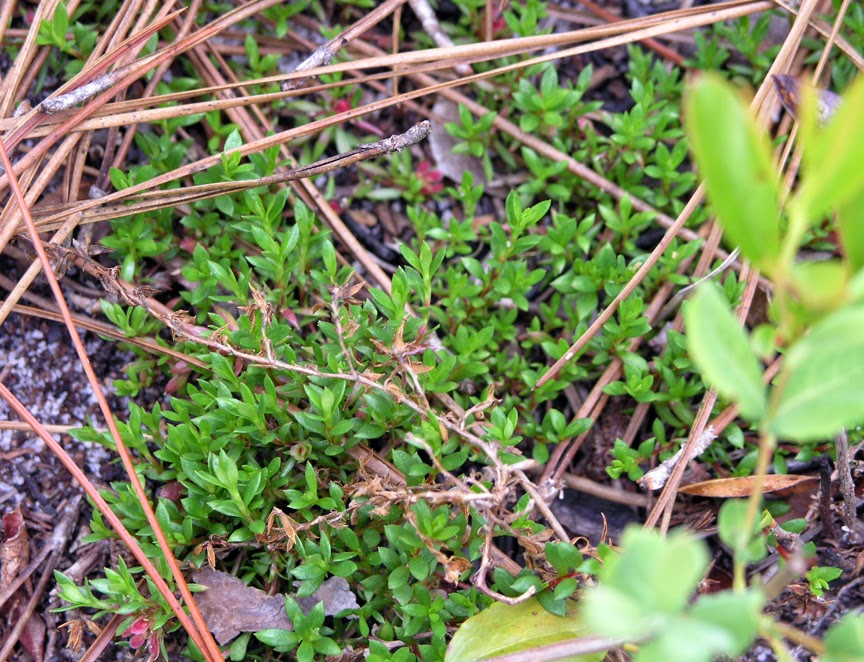 |
| Twin flower (Linnaea borealis) and partridgeberry (Mitchella repens). |
A few Sundays ago I visited a most unusual site with the Piedmont Chapter of the
Virginia Native Plant Society (VNPS).
Ice Mountain Preserve in West Virginia, now owned by the Nature Conservancy, is one of the weirdest places around--a naturally-occurring refrigerator! At the bottom of an
algific (cold-producing) talus slope, air is drawn in thru vents, and insulated by a layer of very thick sandstone blocks underneath, the air is cooled, causing ice to form inside small cavities on the side of the hill. The cold air flowing from these vents creates a micro-climate on one side of the trail, where plants normally found in sub-artic regions such as northern Canada can flourish. This site has been designated as a natural heritage site; access is restricted and arrangements must be made to visit with a guide.
Our group met at the Old Inn in North River Mills, a small town that used to number a few hundred back in the 19th Century and gradually depopulated until only one inhabitant remains at present. Our guide and docent, Kristin, told us that back in the 19th Century the
local inhabitants used to gather the blocks of ice during summer to cool drinks and make ice
cream. Unfortunately this practice depleted much of the ice in the crevices, but some ice can still be found.
 |
| Ice inside a cavity at Ice Mountain |
Storm clouds had been gathering as I drove to the site. As we were starting out on the trail, a peal of thunder warned of the storm's approach, and our group decided to return to the inn and wait until it had passed. A wise decision, as we would have been completely soaked had we continued. Kristin entertained us with stories of the inn, and we explored the interior while waiting for the skies to clear.
Eventually, the rain stopped and we started out again. The path led up a hill, and through woods carpeted with understory plants such as bedstraw, black cohosh, southern beech fern and maidenhair fern, some of which I recognized from previous encounters, but many plants here were new to me, such as this Appalachian wood fern.
 |
| Appalachian wood fern (Gymnocarpium appalachianum) |
 |
| The Cacapon River |
As we descended the other side of the hill and rounded a bend, the path began to parallel the Cacapon River. We were asked to walk single file on the trail, in order to protect the fragile vegetation. Wending our way through a forest of huge Rosebay rhododendrum (
Rhododendrum maximum) which would probably not bloom until July, the temperature became perceptibly cooler as we reached the talus slope.
 |
| Hiking through a forest of rhododendron. |
 |
| Ice Mountain mist |
Mist wafted from the cavities along the base of the talus slope. One of the group had brought a thermometer which we placed inside one of the small cavities. It was about 80 degrees ambient that day, but inside the cavity the thermometer read 38 degrees. Ice could be seen inside one of the larger cavities.
 |
| Ice Mountain crevices |
The rare plants began to appear on the side of the trail with the crevices: Bunchberry (
Cornus canadensis), Canada Mayflower (
Maianthemum canadense), Minnie-bush (
Menziesia pilosa), Nannyberry (
Viburnum lentago), Late low blueberry (
Vaccinium pallidum), and many more that I missed, being too far behind our docent. The range of botanical oddities was impressive.
 |
| Bunchberry (Cornus canadensis) |
 |
| Canada mayflower (Maianthemum canadense) |
 |
| Late low blueberry (Vaccinium pallidum). |
We came across the lovely twin flower (
Linnaea borealis) growing in amazing profusion over just one section of the trail. This low creeper grew intertwined with Partridgeberry, Canada Mayflower, Bunchberry and mosses along the ground. A lone specimen of the Prickly rose (
Rosa acicularis) was so precarious it had been protected from browsing animals behind a small fenced enclosure.
 |
| Twinflower grows profusely over the rocks. |
 |
| Prickly rose (Rosa acicularis) behind fence. |
Our docent Kristin told us that genetic studies of the boreal plants at this site revealed that this group of plants were likely the remnants of vegetation left from the last Ice Age that retreated about 10,000 years ago. Unlike we humans, who can only inherit one set of chromosomes from each parent (haploid), plants, particularly ferns and other flowering plants are capable of inheriting more than one set of chromosomes from each parent to become polyploid. This process happens as plants reproduce over a number of generations, whereas early generations tend to have only two sets of chromosomes, which the plants here were found to have.
Beyond the patch of Twinflower we came across a flowering clump of Northern bedstraw (
Gallium boreale), Skunk currant (
Ribes glandulosum) and Horsetail clubmosses (
Equisetum arvense). The afternoon was waning, so reluctantly, our group started the trek back to the inn. I would have liked to climb up to the top of the hill to observe the ravens nesting there (I had seen them while driving in) but by then my feet had given out. It was time to head home.
 |
| Northern bedstraw (Gallium boreale) |
|
|
 |
| Horsetail clubmoss (Equisetum arvense) and witch hazel seedlings. |
 |
| Skunk currant (Ribes Glandulosum) |
I hope to eventually find time to paint the tiny and exquisite Twinflower, so unique and beautiful!





















































